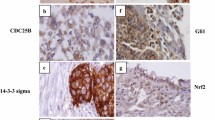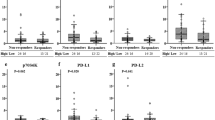Abstract
Background
The transcription factor NF-E2-related factor 2 (Nrf2) was originally identified to be a critical regulator of intracellular antioxidants and phase II detoxification enzymes. Recent studies have shown that high Nrf2 expression gives cancer cells an advantage for survival from anticancer chemotherapy and radiation therapy. The aims of this retrospective study were to examine the expression of Nrf2 in biopsy specimens of esophageal squamous cell carcinoma (ESCC) and to evaluate whether such expression is useful for predicting the response to chemoradiation therapy (CRT).
Methods
A total of 46 patients with ESCC who received curative surgery after CRT from 1997 to 2011 were enrolled in the current study. Nrf2 expression in the biopsy specimens before CRT was examined immunohistochemically using anti-Nrf2 antibody. The correlations between Nrf2 expression and clinical factors and histological and clinical response to CRT were analyzed.
Results
The rate of Nrf2-positive expression was 39 %. Both clinically and histologically, significant correlations were found between positive Nrf2 expression and unfavorable response to CRT. Furthermore, Nrf2 was significantly correlated with clinical lymph node metastases and patients’ postoperative outcomes. Multivariate analysis showed that Nrf2 expression status was an independent prognostic factor.
Conclusions
Nrf2 expression was found to be closely related to the effect of CRT and could predict the CRT outcome in patients with ESCC.


Similar content being viewed by others
References
Naunheim KS, Petruska P, Roy TS, Andrus CH, Johnson FE, Schlueter JM, et al. Preoperative chemotherapy and radiotherapy for esophageal carcinoma. J Thorac Cardiovasc Surg. 1992;103:887–93; discussion 893–5.
Baba M, Aikou T, Yoshinaka H, Natsugoe S, Fukumoto T, Shimazu H, et al. Long-term results of subtotal esophagectomy with three-field lymphadenectomy for carcinoma of the thoracic esophagus. Ann Surg. 1994;219:310–6.
Natsugoe S, Okumura H, Matsumoto M, Uchikado Y, Setoyama T, Yokomakura N, et al. Randomized controlled study on preoperative chemoradiotherapy followed by surgery versus surgery alone for esophageal squamous cell cancer in a single institution. Dis Esophagus. 2006;19:468–72.
Zhang DD. Mechanistic studies of the Nrf2-Keap1 signaling pathway. Drug Metab Rev. 2006;38:769–89.
Shibata T, Saito S, Kokubu A, Suzuki T, Yamamoto M, Hirohashi S. Global downstream pathway analysis reveals a dependence of oncogenic NF-E2-related factor 2 mutation on the mTOR growth signaling pathway. Cancer Res. 2010;70:9095–105.
Venugopal R, Jaiswal AK. Nrf1 and Nrf2 positively and c-Fos and Fra1 negatively regulate the human antioxidant response element-mediated expression of NAD(P)H:quinone oxidoreductase1 gene. Proc Natl Acad Sci U S A. 1996;93:14960–5.
Zhang DD, Lo SC, Cross JV, Templeton DJ, Hannink M. Keap1 is a redox-regulated substrate adaptor protein for a Cul3-dependent ubiquitin ligase complex. Mol Cell Biol. 2004;24:10941–53.
Ishii T, Itoh K, Takahashi S, Sato H, Yanagawa T, Katoh Y, et al. Transcription factor Nrf2 coordinately regulates a group of oxidative stress-inducible genes in macrophages. J Biol Chem. 2000;275:16023–9.
Katoh Y, Itoh K, Yoshida E, Miyagishi M, Fukamizu A, Yamamoto M. Two domains of Nrf2 cooperatively bind CBP, a CREB binding protein, and synergistically activate transcription. Genes Cells. 2001;6:857–68.
Banning A, Deubel S, Kluth D, Zhou Z, Brigelius-Flohe R. The GI-GPx gene is a target for Nrf2. Mol Cell Biol. 2005;25:4914–23.
Shibata T, Kokubu A, Gotoh M, Ojima H, Ohta T, Yamamoto M, et al. Genetic alteration of Keap1 confers constitutive Nrf2 activation and resistance to chemotherapy in gallbladder cancer. Gastroenterology. 2008;135:1358–1368, e1–4.
Cho HY, Reddy SP, Kleeberger SR. Nrf2 defends the lung from oxidative stress. Antioxid Redox Signal. 2006;8:76–87.
Kensler TW, Wakabayash N, Biswal S. Cell survival responses to environmental stresses via the Keap1-Nrf2-ARE pathway. Annu Rev Pharmacol. 2007;47:89–116.
Lau A, Villeneuve NF, Sun Z, Wong PK, Zhang DD. Dual roles of Nrf2 in cancer. Pharmacol Res. 2008;58:262–70.
Stacy DR, Ely K, Massion PP, Yarbrough WG, Hallahan DE, Sekhar KR, et al. Increased expression of nuclear factor E2 p45-related factor 2 (NRF2) in head and neck squamous cell carcinomas. Head Neck. 2006;28:813–8.
Ohta T, Iijima K, Miyamoto M, Nakahara I, Tanaka H, Ohtsuji M, et al. Loss of Keap1 function activates Nrf2 and provides advantages for lung cancer cell growth. Cancer Res. 2008;68:1303–9.
Homma S, Ishii Y, Morishima Y, Yamadori T, Matsuno Y, Haraguchi N, et al. Nrf2 enhances cell proliferation and resistance to anticancer drugs in human lung cancer. Clin Cancer Res. 2009;15:3423–32.
Li W, Kong AN. Molecular mechanisms of Nrf2-mediated antioxidant response. Mol Carcinog. 2009;48:91–104.
Zhang P, Singh A, Yegnasubramanian S, Esopi D, Kombairaju P, Bodas M, et al. Loss of Kelch-like ECH-associated protein 1 function in prostate cancer cells causes chemoresistance and radioresistance and promotes tumor growth. Mol Cancer Ther. 2010;9:336–46.
Ma X, Zhang J, Liu S, Huang Y, Chen B, Wang D. Nrf2 knockdown by shRNA inhibits tumor growth and increases efficacy of chemotherapy in cervical cancer. Cancer Chemother Pharmacol. 2012;69:485–94.
Chen Y, Jungsuwadee P, Vore M, Butterfield DA, Clair DKS. Collateral damage in cancer chemotherapy—Oxidative stress in nontargeted tissues. Mol Interv. 2007;7:147–56.
Kim JH, Bogner PN, Ramnath N, Park Y, Yu J, Park YM. Elevated peroxiredoxin 1, but not NF-E2-related factor 2, is an independent prognostic factor for disease recurrence and reduced survival in stage I non-small cell lung cancer. Clin Cancer Res. 2007;13:3875–82.
Cho JM, Manandhar S, Lee HR, Park HM, Kwak MK. Role of the Nrf2-antioxidant system in cytotoxicity mediated by anticancer cisplatin: implication to cancer cell resistance. Cancer Lett. 2008;260:96–108.
Sobin LH, Wittekind Ch, eds. International union against cancer (UICC) TNM classification of malignant tumors (ICD-O C15). 6th ed. New York: Wiley. 2002.
Tahara M, Ohtsu A, Hironaka S, Boku N, Ishikura S, Miyata Y, et al. Clinical impact of criteria for complete response (CR) of primary site to treatment of esophageal cancer. Jpn J Clin Oncol. 2005;35:316–23.
Takubo K, Makuuchi H, Fujita H, Aikou T, Kajiyama Y, Kawano T, et al. Japanese classification of esophageal cancer, 10th ed. Part I. Esophagus. 2009;6:1–25.
Takubo K, Makuuchi H, Fujita H, Aikou T, Kajiyama Y, Kawano T, et al. Japanese classification of esophageal cancer, 10th ed. Parts II and III. Esophagus. 2009;6:71–94.
Solis LM, Behrens C, Dong W, Suraokar M, Ozburn NC, Moran CA, et al. Nrf2 and Keap1 abnormalities in non-small cell lung carcinoma and association with clinicopathologic features. Clin Cancer Res. 2010;16:3743–53.
Boulikas T, Vougiouka M. Cisplatin and platinum drugs at the molecular level (review). Oncol Rep. 2003;10:1663–82.
Siddik ZH. Cisplatin: mode of cytotoxic action and molecular basis of resistance. Oncogene. 2003;22:7265–79.
Wang XJ, Sun Z, Villeneuve NF, Zhang S, Zhao F, Li Y, et al. Nrf2 enhances resistance of cancer cells to chemotherapeutic drugs, the dark side of Nrf2. Carcinogenesis. 2008;29:1235–43.
Wang J, Zhang M, Zhang L, Cai H, Zhou S, Zhang J, et al. Correlation of Nrf2, HO-1, and MRP3 in gallbladder cancer and their relationships to clinicopathologic features and survival. J Surg Res. 2010;164:e99–105.
Okumura H, Natsugoe S, Matsumoto M, Yokomakura N, Uchikado Y, Takatori H, et al. The predictive value of p53, p53R2, and p21 for the effect of chemoradiation therapy on oesophageal squamous cell carcinoma. Br J Cancer. 2005;92:284–9.
Acknowledgment
This study is supported by a Grant in Aid for Scientists from the Ministry of Education, Culture, Sports, Science and Technology of Japan (Grant Number 10398282).
Disclosures
There are no financial disclosures from any authors.
Author information
Authors and Affiliations
Corresponding author
Electronic supplementary material
Below is the link to the electronic supplementary material.
Rights and permissions
About this article
Cite this article
Kawasaki, Y., Okumura, H., Uchikado, Y. et al. Nrf2 is Useful for Predicting the Effect of Chemoradiation Therapy on Esophageal Squamous Cell Carcinoma. Ann Surg Oncol 21, 2347–2352 (2014). https://doi.org/10.1245/s10434-014-3600-2
Received:
Published:
Issue Date:
DOI: https://doi.org/10.1245/s10434-014-3600-2




